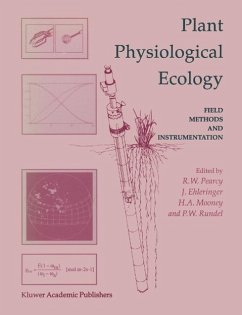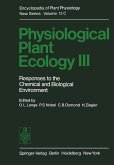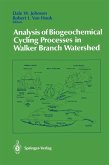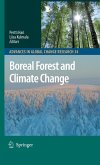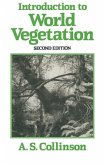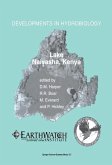capable of providing at least a relative measure of stomatal aperture were first used shortly thereafter (Darwin and Pertz, 1911). The Carnegie Institution of Washington's Desert Research Laboratory in Tucson from 1905 to 1927 was the first effort by plant physiologists and ecologists to conduct team research on the water relations of desert plants. Measurements by Stocker in the North African deserts and Indonesia (Stocker, 1928, 1935) and by Lundegardh (1922) in forest understories were pioneering attempts to understand the environmental controls on photosynthesis in the field. While these early physiological ecologists were keen observers and often posed hypotheses still relevant today they were strongly limited by the methods and technologies available to them. Their measurements provided only rough approximations of the actual plant responses. The available laboratory equip ment was either unsuited or much more difficult to operate under field than laboratory conditions. Laboratory physiologists distrusted the results and ecologists were largely not persuaded of its relevance. Consequently, it was not until the 1950s and 1960s that physiological ecology began its current resurgence. While the reasons for this are complicated, the development and application of more sophisticated instruments such as the infrared gas analyzer played a major role. In addition, the development of micrometeorology led to new methods of characterizing the plant environments.
Dieser Download kann aus rechtlichen Gründen nur mit Rechnungsadresse in A, B, BG, CY, CZ, D, DK, EW, E, FIN, F, GR, HR, H, IRL, I, LT, L, LR, M, NL, PL, P, R, S, SLO, SK ausgeliefert werden.
"The combination of methods descriptions, comparative evaluations, and extensive citations makes this volume a bookshelf must for any scientist studying plant responses to the environment. It also has a wealth of good information for students" -- Plant Sciences Bulletin
"This book provides a guide to the appropriate methodology for field measurements of the environment and of the physiological and morphological responses of plants to their environment, relevant to the study of physiological ecology ... This book provides a valuable reference work for researchers and those involved in the pure and applied plant sciences" -- Field Crop Abstracts
"...this is one of the best books on plant physiology ecology it is one of the best I have had the honor to review...One of the nicest features..is the abundance of clear, informative illustrations..It is clearly a book worth having" -- BioScience
"...Every practicing physiological ecologist should have a copy..." -- Quarterly Review of Biology
"...Altogether this book contains a lot of valuable information which is helpful not only for someone being new in the field but also for researchers already familiar with a certain technique. The book is worth its price and can be recommended for a wide range of plant physiologists" -- Journal of Plant Physiology
"This book provides a guide to the appropriate methodology for field measurements of the environment and of the physiological and morphological responses of plants to their environment, relevant to the study of physiological ecology ... This book provides a valuable reference work for researchers and those involved in the pure and applied plant sciences" -- Field Crop Abstracts
"...this is one of the best books on plant physiology ecology it is one of the best I have had the honor to review...One of the nicest features..is the abundance of clear, informative illustrations..It is clearly a book worth having" -- BioScience
"...Every practicing physiological ecologist should have a copy..." -- Quarterly Review of Biology
"...Altogether this book contains a lot of valuable information which is helpful not only for someone being new in the field but also for researchers already familiar with a certain technique. The book is worth its price and can be recommended for a wide range of plant physiologists" -- Journal of Plant Physiology
The combination of methods descriptions, comparative evaluations, and extensive citations makes this volume a bookshelf must for any scientist studying plant responses to the environment. It also has a wealth of good information for students - Plant Sciences Bulletin; This book provides a guide to the appropriate methodology for field measurements of the environment and of the physiological and morphological responses of plants to their environment, relevant to the study of physiological ecology ... This book provides a valuable reference work for researchers and those involved in the pure and applied plant sciences - Field Crop Abstracts; ...this is one of the best books on plant physiology ecology it is one of the best I have had the honor to review...One of the nicest features..is the abundance of clear, informative illustrations..It is clearly a book worth having - BioScience; ...Every practicing physiological ecologist should have a copy... - QuarterlyReview of Biology; ...Altogether this book contains a lot of valuable information which is helpful not only for someone being new in the field but also for researchers already familiar with a certain technique. The book is worth its price and can be recommended for a wide range of plant physiologists - Journal of Plant Physiology

